MCS 70 / Wonderama / Cinerama |
Read more at in70mm.com The 70mm Newsletter |
| Written by: Gerhard Witte, Berlin (Germany) | Date: 22.06.2015 |
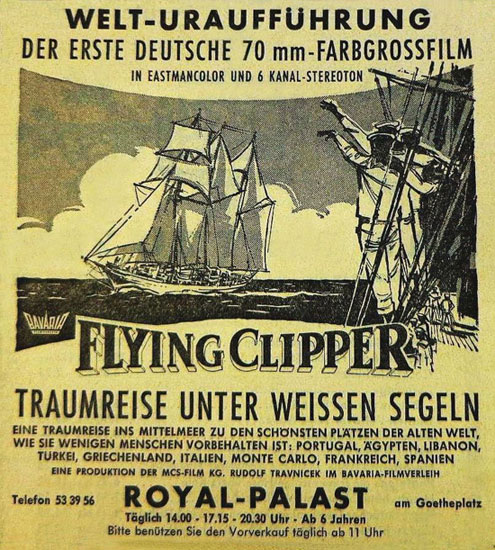 The
movie's World Premiere advert in the newspaper "Münchner Merkur" dated
Thursday, December 20, 1962 – the festive event took place one day
earlier, on December 19. "Under the patronage of the President of the
German Parliament Dr. Eugen Gerstenmaier" had been written in the
movie's announcements. At the premiere were also present the movie's
producer Rudolf Travnicek, the directors Rudolf Nussgruber and Hermann
Leitner, the composer Riz Ortolani and his wife, singer Katyna Ranieri,
and seamen of the Flying Clipper. The
movie's World Premiere advert in the newspaper "Münchner Merkur" dated
Thursday, December 20, 1962 – the festive event took place one day
earlier, on December 19. "Under the patronage of the President of the
German Parliament Dr. Eugen Gerstenmaier" had been written in the
movie's announcements. At the premiere were also present the movie's
producer Rudolf Travnicek, the directors Rudolf Nussgruber and Hermann
Leitner, the composer Riz Ortolani and his wife, singer Katyna Ranieri,
and seamen of the Flying Clipper."Flying Clipper – Traumreise unter weißen Segeln" (Mediterranean Holiday, West Germany, runtime 154 min, AR 1:2.21), perhaps a German answer to the successful Cinemiracle movie "Windjammer: The Voyage of the Christian Radich" (USA, 1958), had its World Premiere at Munich's "Royal-Palast" on Goetheplatz on Wednesday, December 19, 1962. The travelogue is the first German feature film production shot in the new wide-gauge film process called "MCS 70" which had been developed by Modern Cinema Systems (MCS) Film KG. (Rudolf Travnicek) in Munich at the time. Recording was done with new, light 65mm reflex cameras ("Field Cameras") – weight without film cassette around 13 kg / 28.6 lbs – which were purpose-designed and built by the Norwegian engineer Jan Jacobsen (1916-1998). The results were then printed onto 70mm positive film additionally equipped with 6-channel magnetic sound. |
More in 70mm reading: Der Reisefilm "Flying Clipper – Traumreise unter weißen Segeln" in Deutschland und in den USA "Flying Clipper" Wolfram Hannemann's Film Introductions for the Widescreen Weekend 2010 A new 70mm print of "FlyingClipper" Dream Journeys: The M.C.S.-70 Process and European Cinema of the 1960s To Split or not to Split ... That is the Hollywood Question! Arc-120 Gives Wider Vistas Gerhard Witte's in70mm.com Library Internet link: American Widescreen Museum incinerama.com The "Thrillarama" process The Walter Reade Organization: ZEISS Germany: "Luna del miel", the whole movie in Spanish on YouTube: "Flying Clipper – Traumreise unter weißen Segeln" a German trailer: "Old Shatterhand" info and images, an impressive website by Stefan Kubale |
A "Windjammer War" between Cinerama / Cinemiracle, Inc. in New York, and M.C.S. Film KG. in Munich |
|
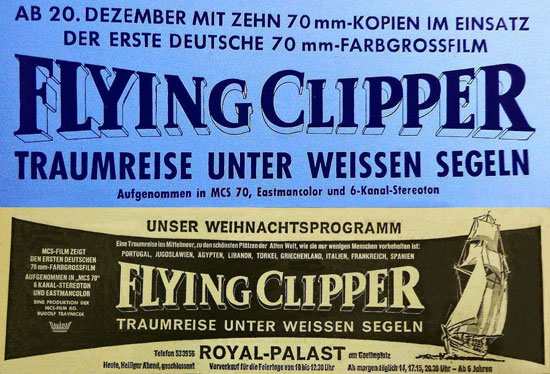 From
December 20, 1962, with ten 70mm prints in use. The first German 70mm
major color film. "Flying Clipper – Traumreise unter weißen Segeln"
(Flying Clipper – Dream Voyage under White Sails) filmed in MCS 70,
Eastman Color and with 6-Channel Stereo Sound. Below: An advert dated
Monday, December 24, 1962 – the movie at Munich's "Royal-Palast" during
Christmas Time. From
December 20, 1962, with ten 70mm prints in use. The first German 70mm
major color film. "Flying Clipper – Traumreise unter weißen Segeln"
(Flying Clipper – Dream Voyage under White Sails) filmed in MCS 70,
Eastman Color and with 6-Channel Stereo Sound. Below: An advert dated
Monday, December 24, 1962 – the movie at Munich's "Royal-Palast" during
Christmas Time."A dream trip to the Mediterranean to the most attractive places of the Ancient World which is left up to only few people: Portugal, Yugoslavia, Egypt, Lebanon, Turkey, Greece, Italy, France and Spain." The marketing of Cinemiracle's successful film "Windjammer: The Voyage of the Christian Radich" (USA, 1958) was taken on at the time by the newly founded Munich company Modern Cinema Systems (MCS) Film KG. (Rudolf Travnicek) acting on behalf of the U.S. companies Cinemiracle International, Inc. and National Theatres. Just in time of the German Gymnastics Festival in Munich (20.07.1958 - 28.07.1958) "Windjammer: The Voyage of the Christian Radich" debuted in Germany at "Royal-Palast" on Tuesday, July 22, 1958. The start-up costs were about DM 70.000. At the time, the around 16.000 kg heavy Cinemiracle equipment had been directly flown in from Hollywood to Munich (source: "Filmwoche"). The cinema operator, Rudolf Englberth, hired the elaborate and expensive film equipment. Later, in 1961, when M.C.S. Film KG. began the production of its own film initially titled "Flying Clipper – Traumreise eines Windjammer" (Flying Clipper – Dream Voyage of a Windjammer), the working title had been at the time "Windjammer 2", they met with the displeasure of Cinemiracle International Pictures (by now a subsidiary of Cinerama, Inc.) in America, and it was seen as an infringement of rights. The Cinerama lawyers declared that the German company at issue was, as the licence holder for the Cinemiracle film "Windjammer: The Voyage of the Christian Radich" (USA, 1958) in Germany, also bound by the terms of that contract. They therefore concluded that the German party to the contract was prohibited from producing, copying, showing or distributing a wide-screen film of this type or from issuing a licence for one. |
|
 ...we
are in Egypt on board of the ship "Flying Clipper" and shooting will
continue as planned – to date the most expensive German film project. The
first German 70mm colour film shot in a German 70mm process named MCS 70.
Image left: The M.C.S. Film KG. / Bavaria Filmverleih GmbH. information.
Image right: "Flying Clipper" – announcement of the movie's premiere at West
Berlin's "Delphi-Filmpalast am Zoo" which took place on Friday, February 15,
1963. ...we
are in Egypt on board of the ship "Flying Clipper" and shooting will
continue as planned – to date the most expensive German film project. The
first German 70mm colour film shot in a German 70mm process named MCS 70.
Image left: The M.C.S. Film KG. / Bavaria Filmverleih GmbH. information.
Image right: "Flying Clipper" – announcement of the movie's premiere at West
Berlin's "Delphi-Filmpalast am Zoo" which took place on Friday, February 15,
1963.Around March 20th, 1962, M.C.S. Film KG. / Bavaria Filmverleih GmbH. published a large announcement (see image) in a range of trade magazines saying the following: Information: We are the producers and distributors of the film "Flying Clipper – Traumreise eines Windjammer" (Flying Clipper – Dream Voyage of a Windjammer). We have been planning this film for over a year and filming since May 1961 and we will continue filming as planned. We do not require any permission for our film from Cinemiracle International Picture, Inc., New York, because our film: 1.) Is a travel documentary based on an original film script developed by us and does not infringe any protected rights of others. 2.) Is not filmed using Cinemiracle's three-strip system, but using the MCS 70mm process allowing seamless projection. 3.) Has nothing to do with the Cinemiracle film "Windjammer: The Voyage of the Christian Radich". We must in no uncertain terms reject the claim that there has been an infringement of the rights of the Cinemiracle company, and we reserve the right to take appropriate action to compel the Cinemiracle company to withdraw this accusation and forebear from making any future accusations of this type. We chose the title "Flying Clipper" with the addition "Traumreise eines Windjammer" (Dream Voyage of a Windjammer), because our ship is called "Flying Clipper", and the word "Windjammer" in the title is purely a generic term meaning nothing more than a large sailing ship. The completion of the film will continue unhindered. M.C.S. Film KG. (Munich) Bavaria Filmverleih GmbH. (Munich) |
|
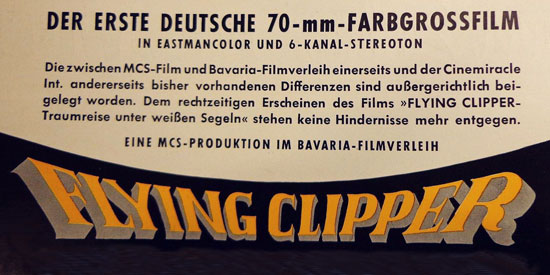 On
June 13, 1962, the following short article appeared in "New York
VARIETY": Cinemiracle Wins First Step in Suit Vs. German Producer's
"Windjammer". Munich, on Tuesday, June 05, 1962. On
June 13, 1962, the following short article appeared in "New York
VARIETY": Cinemiracle Wins First Step in Suit Vs. German Producer's
"Windjammer". Munich, on Tuesday, June 05, 1962.According to a temporary injunction issued by Munich's County Court, Bavaria Film and producers Hardt and Travnicek are for the time being restricted from "announcing, promoting and showing" their forthcoming film under the title "Flying Clipper – Dream Voyage of a Windjammer". Court order followed a complaint by Cinemiracle International, New York, to the effect that the German picture presently being shot aboard and around a sailing vessel on a Mediterranean trip would constitute a copyright infringement on the Cinemiracle 1958 picture "Windjammer: The Voyage of the Christian Radich", if already existing similarities in other aspects were further pointed up by a monicker containing the word "Windjammer". Defendants claim that one-word titles could not be regarded as the result of "creative invention" and therefore were not protected by law as the idea of doing a cine-travelogue with a windjammer cruise as subject matter. Hearing is set for June 18. The movie's title was subsequently changed twice by M.C.S. Film KG. at the time. From "Flying Clipper – Traumreise eines Windjammer" (Flying Clipper – Dream Voyage of a Windjammer) it was renamed "Flying Clipper – Traumreise eines Dreimasters" (Flying Clipper – Dream Voyage of a Three-Master), and eventually they agreed on "Flying Clipper – Traumreise unter weißen Segeln" (Flying Clipper – Dream Voyage under White Sails). On September 01, 1962, the German trade magazine "Film-Echo/Filmwoche" (No.70) reported: "Flying Clipper" stopped in England. The American Cinemiracle International Picture, Inc. has obtained an injunction enjoying legal force until October 02, 1962, which legally prohibits M.C.S. Film KG. in Munich and Rudolph Travnicek from further production, copying or showing of the film "Flying Clipper". This injunction means primarily that all work on copying the film at Technicolor London ceases. Cinemiracle, a subsidiary of Cinerama, Inc., alleges that Rudolf Travnicek has, with his Flying Clipper project, breached contractual agreements that he entered into some years ago on taking on the film "Windjammer: The Voyage of the Christian Radich". (hjw) |
|
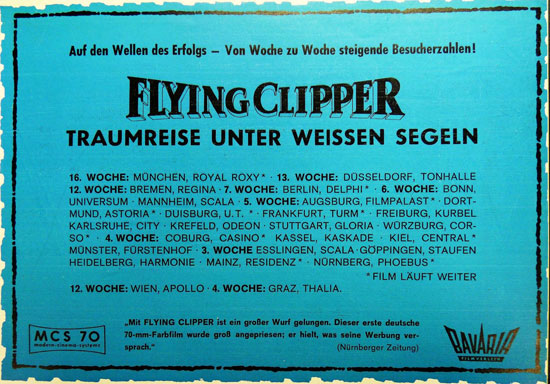 An
advertisement of Bavaria Film: On the waves of success – from week to week a
constantly rising number of cinemagoers! Now 16 weeks in Germany – 12 weeks
in Austria. "This first German 70mm color film has been highly touted and
has lived up to its advertising claims." (Nuremberg newspaper) An
advertisement of Bavaria Film: On the waves of success – from week to week a
constantly rising number of cinemagoers! Now 16 weeks in Germany – 12 weeks
in Austria. "This first German 70mm color film has been highly touted and
has lived up to its advertising claims." (Nuremberg newspaper) In mid-October 1962, M.C.S. Film KG. issued the following statement in some trade magazines. "The differences that existed between M.C.S. Film and Bavaria Filmverleih on the one hand and Cinemiracle, Inc. on the other have been settled out of court. There are no further obstacles to the film "Flying Clipper – Traumreise unter weißen Segeln" (Flying Clipper – Dream Voyage under White Sails) being released on the due date." Following its Munich world premiere on 19.12.1962, the film went on to be released to various first-run cinemas, where it subsequently met with success. In the beautiful Hanseatic city of Hamburg the movie had its premiere in 70mm at the "Ufa-Palast am Gänsemarkt" on Friday, April 26, 1963, where it subsequently ran for eight weeks until Thursday, June 20, 1963. The website of the German Federal Archive reports about the newly struck 70mm print of the movie shown for the first time at the Berlin International Film Festival in 2009. |
|
Screening "Flying Clipper" in the USA
|
|
 Registered
patent data – Data provided by IFI CLAIMS Patent Services: Film and
apparatus for generating wide screen images as well as methods for producing
such a film. Publication number: DE 1157913 B / Publication type:
Registration / Registration number: DE 1958B0049743 / Release date: Nov. 21,
1963 / Registered: July 22, 1958 / Priority date: April 04, 1958 – Inventor:
Leon Weliczker Wells – Applicant: Leon Bronesky. Registered
patent data – Data provided by IFI CLAIMS Patent Services: Film and
apparatus for generating wide screen images as well as methods for producing
such a film. Publication number: DE 1157913 B / Publication type:
Registration / Registration number: DE 1958B0049743 / Release date: Nov. 21,
1963 / Registered: July 22, 1958 / Priority date: April 04, 1958 – Inventor:
Leon Weliczker Wells – Applicant: Leon Bronesky.The success of CINERAMA spawned other similar multiple 35mm projection methods such as "Thrillarama" (1956, 2 projectors, 2 beams), "Cinemiracle" (1958, 3 projectors, 3 beams), or "ARC120" / "Wonderama" (realized start of the 1960s, only 1 projector, 2 beams). "Wonderama", previously already known as "ARC120", was a very short-lived projection process invented by Dr. Leon W. Wells*, an optical research specialist, and has been promoted / developed by the producer Leon J. Bronesky. It has been designed specifically with the small theatre in mind which could not afford the cost of major structural alteration works. * Dr. Leon Weliczker Wells (10.03.1925 - 19.12.2009) inventor of the ARC120 process was born in Poland and was a noted American scientist, physicist, optometrist and author. He was a Jewish survivor of the Holocaust. He emigrated to the USA in 1949. In May 1961, he was heard as a witness at the trial of Adolf Eichmann in Jerusalem. |
|
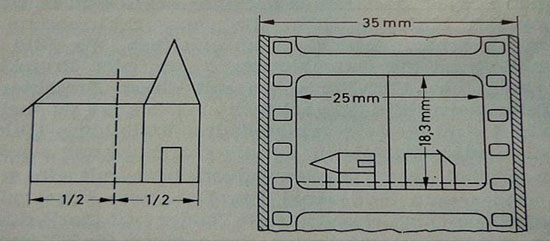 The
ARC120 process. On the left: The splitting of the original image into
two halves (2 x spherical). On the right: The two half-images now
vertically printed "foot-to-foot" within a frame of a 35mm film using an
image area of 0,98 x 0,72 inches / 25 x 18,3 mm. The magnetic sound
tracks (e.g. Stereo) are placed outside the perforation on the film's
edges. The drawing is taken from the German trade magazine "Kinotechnik"
(No.11/1960) The
ARC120 process. On the left: The splitting of the original image into
two halves (2 x spherical). On the right: The two half-images now
vertically printed "foot-to-foot" within a frame of a 35mm film using an
image area of 0,98 x 0,72 inches / 25 x 18,3 mm. The magnetic sound
tracks (e.g. Stereo) are placed outside the perforation on the film's
edges. The drawing is taken from the German trade magazine "Kinotechnik"
(No.11/1960)On YouTube there is a long interview (1996) with him – "Jewish Survivor Leon Wells Testimony". Also Wikipedia (Germany) informs about Wells and his hard life. In order to produce films (prints) for the "Wonderama / ARC120" projection, base material was preferably originated from high-resolution wide-gauge negative films, like Technirama or 65mm – to obtain best image quality. In this process each individual image of a film was subsequently split into two halves. Then, the two half-images were rotated and were vertically printed "foot-to-foot" within a single frame of a 35mm negative film (see image), which has the frame area size of a silent film (0,98 x 0,72 inches). Anamorphic base material had been previously optically decompressed (without distortion). Wells claimed at the time that a major advantage is that the loss of picture quality often due to anamorphic projection lenses is now eliminated. |
|
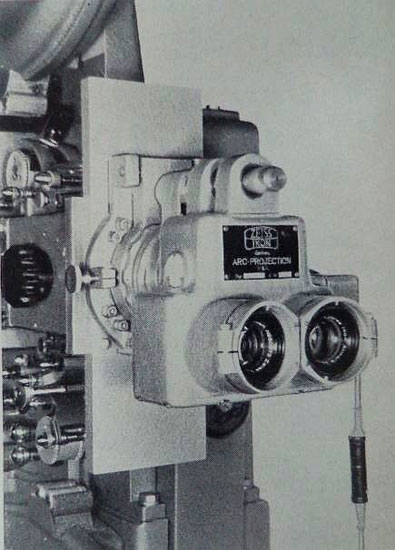 The
ARC projection attachment ("20-16") with its two lenses developed by Zeiss
Ikon AG (Kiel) in Germany mounted on an "Ernemann VIII B" projector. (Photo:
Zeiss Ikon AG – by courtesy of ZEISS Germany) The
ARC projection attachment ("20-16") with its two lenses developed by Zeiss
Ikon AG (Kiel) in Germany mounted on an "Ernemann VIII B" projector. (Photo:
Zeiss Ikon AG – by courtesy of ZEISS Germany)The screening took place from a single 35mm projector (at standard 24 fps) on which had been mounted a so-called ARC120 projection attachment, developed by "Zeiss Ikon AG" in Kiel (Germany), equipped with two projection lenses. In Germany the method was presented to the public for the first time at the Photokina in Cologne from 24.09.1960 till 02.10.1960. Due to the twin-projection, the movie could be shown on a deeply curved screen without loss of sharpness. The sound was carried as two magnetic tracks on the edges of the film, outside of the perforation. ARC 120 was first presented (tested) with Michael Powell's movie "Luna del Miel" (Honeymoon, UK/ Spain, 1959, running time 109 min - from IMDb). This was most likely in Blackpool (England) in August 1960. "The journey across Spain is a feast for the eyes, and the spirited, dramatic flamenco dancing cannot fail to stir the soul!" A major restoration of this film, not the ARC120 version, had been done by Charles Doble. He presented it with a new 35mm Scope print at the San Sebastian Film Festival (Spain) in September 2002 and gave following information on the subject: "At the time of the movie's release it was originally produced in stereo – a four track magnetic version. Visually, it was released in both ARC120 and Technirama. These were very new processes. One of these, ARC120, was an attempt to get over the problems of loss of focus where projection was onto large curved screens. This involved a complicated and heavy series of projection lenses (author's comment: The Arc120 attachment) mounted on the front of the 35mm projector. Each cell of the film was divided vertically into two halves. From a projection point of view it was a nightmare to get the two halves to meet seamlessly in the center of the screen and at the same time." |
|
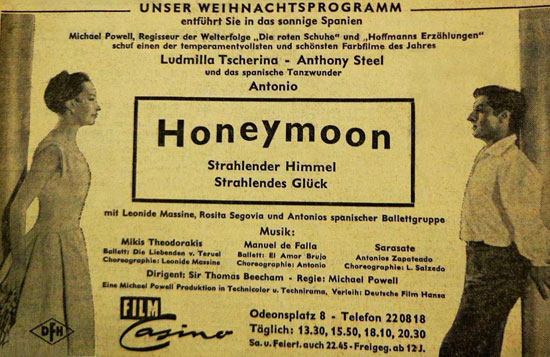 Additional
information about the
movie, and from the
Powell & Pressburger Pages. Additional
information about the
movie, and from the
Powell & Pressburger Pages. "Even with the largest projectors, the colossally heavy adaptor for the ARC120 process caused uncontrollable picture shake. It is remarkable how much material has survived for the restoration – both the original ARC120 and Technirama prints and negatives (the prints having turned to a "claret" shade of pink), all the original stereo magnetic track negs and, interestingly, many original outtakes not ever included in the final print." In Germany, the movie got the title "Honeymoon – strahlender Himmel, strahlendes Glück" (runtime 100 min). It premiered at the Munich "Film-Casino" on December 18, 1959 (see advert) and on December 21, 1959, in various German cinemas (information from "Filmblätter" / "Film-Echo"). It was not an ARC120 version – most likely a 35mm Scope print. |
|
"Flying Clipper" not successfully presented in Wonderama |
|
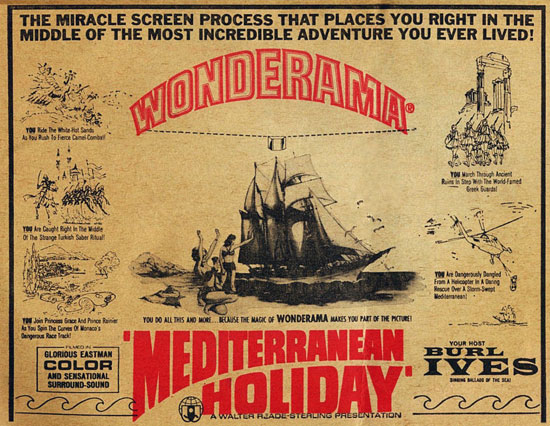 An
advertisement of the movie "Mediterranean Holiday" presented in the U.S. in
"Wonderama" for the first time. "Wonderama in Trenton" images courtesy of
Roland Lataille from
incinerama.com An
advertisement of the movie "Mediterranean Holiday" presented in the U.S. in
"Wonderama" for the first time. "Wonderama in Trenton" images courtesy of
Roland Lataille from
incinerama.comFor screenings in America Walter Reade Jr., owner of a small theatre chain and a film distribution company, and chairman of Walter Reade-Sterling Company, bought the rights to the German-made 70mm film and converted it into the unusual "ARC120" projection process now renamed "Wonderama". The movie got the new title "Mediterranean Holiday" and had its public "Wonderama" World Premiere at the "Strand Theatre" in Plainfield, New Jersey, on Thursday, March 05, 1964. It had been additionally fitted up with commentaries and songs by Burl Ives and perhaps with some extra shot brief scenes. In the advert is written: The Miracle Screen Process That Places You Right In The Middle Of The Most Incredible Adventure You Ever Lived! A Walter Reade-Sterling Presentation, filmed in Glorious Eastman Color and Sensational Surround Sound. You do all this and more because the magic of "Wonderama" makes you part of the picture! Your Host: Burl Ives, who also sings Ballads of the Sea! You Ride The White Hot Sands As You Rush Fierce Camel-Combat! – You Are Caught Right In The Middle Of The Strange Turkish Saber Ritual! – You Join Princess Grace And Prince Rainier As You Spin The Curves Of Monaco's Dangerous Race Track! – You March Through Ancient Ruins In Step With The World-Famed Greek Guards! – You Are Dangerously Dangled From A Helicopter In A Daring Rescue Over A Storm Swept Mediterranean! The first U.S. "Wonderama" premiere (screening) had been planned with "Mediterranean Holiday" at a cinema, most likely at the "Cinerama Theatre" (former "Colonial") in Hartford, Connecticut, in the third calendar week of 1964 (January) *). But it gave technical problems and the screening was postponed at the time. Another premiere was announced at Reade's "RKO Trent Theatre" in Trenton, New Jersey, on Thursday, January 23, 1964. Use following link in order to study a leaflet (see image) which had been distributed for the expected premiere of "Mediterranean Holiday" in the "Wonderama" process in Trenton at the time. But then, unsolved technical issues unfortunately forced further delays and, ultimately, a cancellation of the movie at both cinemas. Finally, the movie's festive "Wonderama" public premiere took place at the "Strand Theatre" in Plainfield, New Jersey, on Thursday, March 05, 1964. |
*) From the author new information 08.10.2017: The public premiere should take place at Hartford´s "Strand Theatre" (the same name as in Plainfield), and not at the "Cinerama Theatre", on Friday, January 17, 1964. Previously, the cinema had been closed for 3 days for the installation of a big, 60 feet wide, and deeply curved screen that covered 120 degrees of vision. |
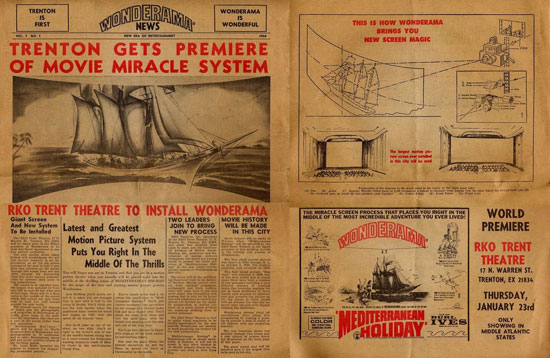 All
this can be read in following interesting articles: "New York
VARIETY" dated Wednesday, January 22, 1964: Reade Postpones "Wonderama"
Bow. Hartford, January 21, 1964. All
this can be read in following interesting articles: "New York
VARIETY" dated Wednesday, January 22, 1964: Reade Postpones "Wonderama"
Bow. Hartford, January 21, 1964. American premiere of "Wonderama" process of projection and screening was postponed here last week when discovery was made that special German lens was of wrong caliber and did not respond to mathematical computations for the process. Quickly obtained American-made optic could have served the purpose but didn't fill out the curved screen and it was decided to postpone until proper lens was secured. Radio and TV time as well as newspaper ads informed public of the cancellation of the showcasing. Press preview was also cancelled. Film scheduled to be shown in color was "Mediterranean Holiday", a travelogue. "Wonderama" is owned by Walter Reade-Sterling, Inc. It is another version of the wide screen, in depth optic type of screening. It is expected "Wonderama" will be packaged and franchised on an exclusive basis to film houses across the nation. The special film lens has to be adapted to projectors, and the screen will be furnished by Reade. It is expectedly a low cost factor to theatres in so far as there is no great investment, no major structural changes (author's comment: Except for the large deeply curved screen), no specially educated or additional operators needed by theatres. Reade will get a percentage of house take and understood also that it will allow film houses to compete with Cinerama and other widescreen projection methods – almost any print of any make and size is compatible to the process and a minimum of cost is required to adapt a print to "Wonderama". "Wonderama" had been tried out in England and in Argentina. A showing this week in Trenton, New Jersey, has been postponed, pending the Hartford showcasing. Inventor of the system is Leon W. Wells, a New York physicist and designer of motion picture equipment. The producer Leon J. Bronesky started the development of the new film projection process in 1955. |
|
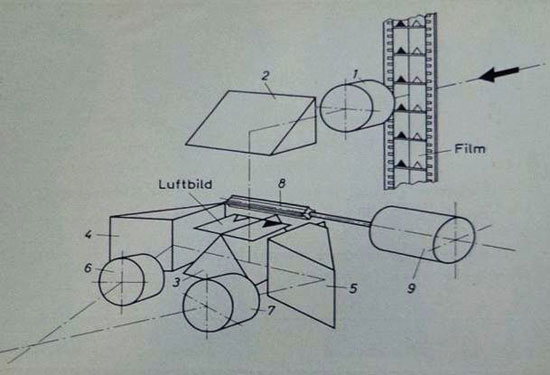 The
principle of the optical system for the ARC120 wide-screen projection. The
drawing is taken from the German trade magazine "Kinotechnik" (No.11/1960). The
principle of the optical system for the ARC120 wide-screen projection. The
drawing is taken from the German trade magazine "Kinotechnik" (No.11/1960).(1) Lens – (2) Prism – (3) Centre Prism – (4 + 5) Front Prisms – (6 + 7) Projection Lenses – (8) The Impulse Blender, an integral rotating shutter, in order to conceal (reduce) the look of the seams where the two half-images (panels) are joining – (9) A speed variable direct current motor for the Impulse Blender. Luftbild = Optical Picture, the overhead optic on which the two partial images come together. Information taken from the German trade magazine "Kinotechnik" (No.11/1960): The dividing line that normally appears in the middle of the projection screen due to the overlapping of the two partial images as they are projected is made almost invisible by the Impulse Blender (8). It is driven by a variable direct current motor (9) at about 10,000 to 15,000 revolutions per minute. In the plane of the Optical Picture, the four edges of the Impulse Blender interrupt the overlap zone of the two partial images with a frequency of about 666 to 1000 Hertz. The procedure could also be described as "optical wobbling" by way of comparison. The speed of the motor is variable, so that periodic luminance fluctuations that may occur due to the creation of beats between the blender frequency and the wobble frequency can be shifted into a range that is no longer detectable to the eye. "New York VARIETY" dated Wednesday, February 26, 1964: "Wonderama" Process Test in Jersey. Walter Reade-Sterling's U.S. premiere of its "Mediterranean Holiday" in the new "Wonderama" process, originally skedded to be held in Hartford last month, has been reset for the "Strand Theatre" in Plainfield, New Jersey, on the evening of March 04 (author's comment: A screening for the press. The movie's public premiere was one day later, on March 05). The Hartford showing had to be cancelled some time ago at the last minute when the proper lenses didn't arrive from Germany. Reade-Sterling is planning to bus film people, reporters and members of the financial community from New York and Philadelphia for the invitational showing in Plainfield. "Wonderama" is a new deep-screen process utilizing 35mm film. |
|
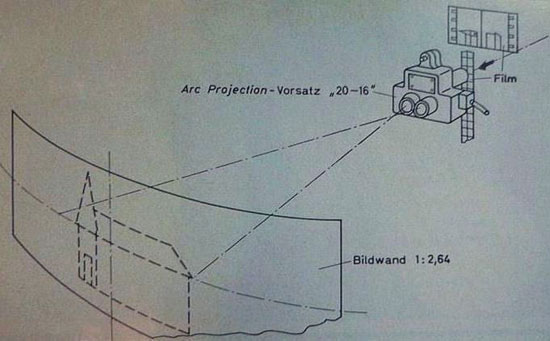 Demonstration
of the ARC 120 wide-screen projection process: The ARC120 attachment,
mounted on a 35mm projector, projects two intersecting beams onto a huge
curved screen. The movie is shown on the screen in an aspect ratio of
1:2.64. The drawing is taken from the German trade magazine "Kinotechnik"
(No.11/1960). Demonstration
of the ARC 120 wide-screen projection process: The ARC120 attachment,
mounted on a 35mm projector, projects two intersecting beams onto a huge
curved screen. The movie is shown on the screen in an aspect ratio of
1:2.64. The drawing is taken from the German trade magazine "Kinotechnik"
(No.11/1960).An extract from an article about the "Wonderama" process written in "Boxoffice" magazine dated March 09, 1964: "Wonderama" Unveiled – New Screen Process. Plainfield, New Jersey, in March 1964. A new and revolutionary screen process known as "Wonderama" was unveiled for the press here on Wednesday (4) at the "Strand Theatre". The innovation was the result of an electronic and prismatic lens invention which involved the printing of the picture frames vertically in two halves instead of horizontally. The two parts are projected and joined together by prismatic optic lenses to fill a deeply curved screen, as in the "Strand Theatre", more than 60 feet wide, more than 21 feet high and a depth in the center of 20 feet. (Author's comment: Another source gives a depth of 16 feet, which is more likely). The first picture to be shown in the new process was "Mediterranean Holiday", in which 20 teenage sea cadets sail a three-master clipper ship to Mediterranean countries. It is a Continental Distributing release, a division of Walter Reade-Sterling, Inc., which also controls the process. "Wonderama" was also designed to provide an evenly lighted picture through the use of one light source, with that light providing double the brilliance normally used in theatre projectors. The "Wonderama" picture uses up to 140 amps of electricity against the normal around 65 amps. (Author's comment: I think that the brilliance of the picture also depends on the screen's size and its light reflection properties). Reade-Sterling claims it is the first system to be developed in which two separate pictures (half-images) can be shown from one projector and, therefore, the first of its kind that can project a motion picture in depth onto a curved screen from a single unit. Ordinarily, it was said, it would not be possible to project depth onto a curved screen with only one lens, because it would be impossible to obtain a complete clear focus at all the different depths of the curve. "Wonderama" does this by dividing the picture and projecting the half-images through prismatic lenses. It can be attached to any 35mm projector. The process was invented by Dr. Leon W. Wells, who was born in Poland and studied in Munich. He came to the United States in 1949 to work at Lehigh University in Bethlehem, Pennsylvania. He holds many awards. According to the brochure on "Wonderama", prepared by Reade-Sterling, the key to the process is in the special 35mm print, which can be run through a standard projector to produce a giant image on the screen. |
|
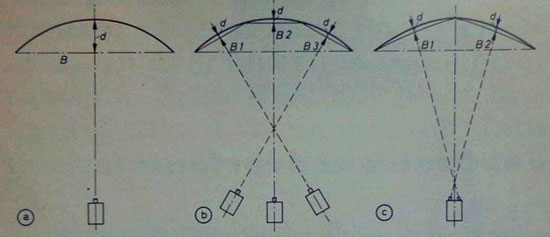 A
schematic representation of diverse projections onto a deeply curved screen.
The drawing is taken from the German trade magazine "Kinotechnik"
(No.11/1960). A
schematic representation of diverse projections onto a deeply curved screen.
The drawing is taken from the German trade magazine "Kinotechnik"
(No.11/1960). a.) One projector (1 image "B", curvature "d" is large) b.) Three projectors "Cinerama" (3 partial images "B1/B2/B3", curvature "d" is small) c.) One projector "ARC120" (2 partial images "B1/B2", curvature "d" is small) An extract from a review about the "Wonderama" premiere in Plainfield: "New York VARIETY" dated Wednesday, March 11, 1964, written by Vincent Canby: Bugs Still Infest Reade's "Wonderama", But Promise of Medium Is Glimpsed. Premiere presentation of Walter Reade-Sterling's new deep-screen process, "Wonderama", at the "Strand Theatre" in Plainfield, New Jersey, Wednesday (4) night, was marred by some eye-straining technical difficulties. The 35mm projection technique, however, does seem to hold promise – if not the poor man's Cinerama, as the small exhibitor's Cinerama, if and when the bugs are ironed out. "Wonderama" is shown in Plainfield via the German-made travelogue feature named "Mediterranean Holiday", which was designed as a sequel to the Cinemiracle film "Windjammer: The Voyage of the Christian Radich" and called in its release overseas "Flying Clipper". "Wonderama" splits the original image of the movie in two, with the two halves then being printed vertically within the 35mm film frame. Via a special prismatic lens fitted onto the projector, the two halves are re-fused on the screen. With what is called a "decoder", within the lens, the seam of the two overlapping partial images is (theoretically) eliminated. However, at the showing caught by this reporter, the seam at screen center was seldom eliminated, and, being at screen center, it was much more annoying than were the seams in the original three-panel Cinerama system. Eye interest inevitably was drawn to the middle of the picture which, because of the seam, was usually out of focus. Additionally, the two halves of the picture seemed to jiggle separately (although both were originating from the same print) and occasionally to converge on one another so that, for example, it once looked as if the clipper ship sailing along at screen center was suddenly "devouring" itself. The screen for the "Strand Theatre" run is 62 feet wide, 22 feet high and 16 feet deep. According to Reade-Sterling chairman Walter Reade Jr., "Wonderama" is being expressly developed for use in those smaller cities and towns whose exhibitors cannot afford to equip for the more expensive Cinerama or 70mm processes. No exhibitor should have to pay more than $3,000 for the proper "Wonderama" screen which can be supplied by any dealer, says Reade. When ready, Reade-Sterling will make the special "Wonderama" lenses available to exhibitors on a "royalty-per-seat basis". At the present time, only "Mediterranean Holiday" has been printed in the process, but Reade told 400-plus reporters and exhibitors, whom he ferried to Plainfield for the occasion that Reade-Sterling plans to have another picture ready before the end of the year. As it now exists, "Wonderama" is simply a process of printing, and requires no special production devices, though it was apparent with "Mediterranean Holiday", which was originally shot on 65mm stock, that the nearly three-to-one aspect ratio of "Wonderama" was obtained at the cost of losing some of the original picture at the top or bottom of the frame. |
|
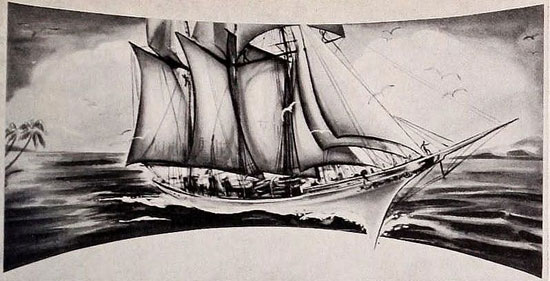 An
American commercial art for the movie "Mediterranean Holiday". An
American commercial art for the movie "Mediterranean Holiday".An extract taken from an article written in the trade magazine "International Projectionist" dated May 1964: "With the Small Theatre in Mind" – Wonderama Augments Capabilities. Walter Reade Jr., said in his company's "Strand Theatre" in Plainfield, New York, that total "Wonderama" conversion of a theatre would cost approximately $3.000. The specialized lens is intended to be lent exhibitors by distributors handling "Wonderama" films. Furthermore, he said that the Strand's per ticket price of $1.25 had increased for "Mediterranean Holiday" to $1.50, and that he expected the picture would run about six weeks, in comparison to two or three weeks for a usually strong feature. Any 35 or 70mm film can be reproduced optically for the "Wonderama" lens, at a cost similar to that for printing a standard 35mm film. To replace a flat or slightly curved screen with a deeply curved "Wonderama" screen can be done between the close of a night performance and the start of the next night performance. The Strand's Simplex X-L projectors and Ashcraft lamphouses were used in the normal 140-ft throw for the "Wonderama" presentation. Lenses are now available for immediate "Mediterranean Holiday" bookings. For now, these lenses are being tooled and ground by Zeiss Ikon works in Germany. Walter Reade-Sterling is now negotiating with an American firm to make the lenses. (ip). Author's comment: Another wide-screen process called "Smith Carney System" was developed in 1958. It also involved the positioning of parts (this time 3) of an image within a single 35mm film frame so that they could be projected through 3 separate optical systems from one projector onto the appropriate portion of a huge curved screen. |
|
"Mediterranean Holiday" in 70mm Cinerama – only CINERAMA can take you on the most wonderful holiday you ever had! |
|
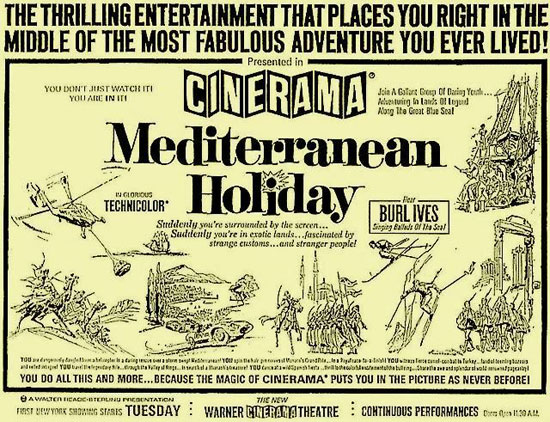 On
Tuesday, December 15, 1964, the movie re-opened, now with a 70mm print,
at New York's "Warner Cinerama Theatre" on Broadway advertised "in
Cinerama", where it subsequently ran for 9 weeks. They reported at the
time: "New York Area Premiere Engagement of 70mm version – previously
screened in 35mm multi-panel `Wonderama'." On
Tuesday, December 15, 1964, the movie re-opened, now with a 70mm print,
at New York's "Warner Cinerama Theatre" on Broadway advertised "in
Cinerama", where it subsequently ran for 9 weeks. They reported at the
time: "New York Area Premiere Engagement of 70mm version – previously
screened in 35mm multi-panel `Wonderama'." Use following link in order to get additional information about Cinerama movies presented at this cinema (with numerous images): An interesting review written in "New York VARIETY" dated Wednesday, December 23, 1964: Mediterranean Holiday (COLOR - CINERAMA) A Walter Reade-Sterling (Continental) presentation of a Bavaria Film Production – Directed by Hermann Leitner, Rudolf Nussgruber – Features: Burl Ives, Captain Skoglund, officers and cadets of the "Flying Clipper" – Screenplay: Gerd Nickstadt, Arthur Elliot, Hans Dieter Bowe – English narration: Burl Ives, William Lovelock – Camera: Siegfried Hold, Heinz Hölscher, Toni Braun, Klaus König, Bernhard Stebich – Aerial shots: Heinrich Schäfer, Heinz Hölscher – Prologue: Howard Dennis, Howard McKenzie, Edward Campbell – Sound: Jean Neny – Music: Composed and conducted by Riz Ortolani – Songs: Music by Ortolani – Lyrics: George Weiss (sung by Katyna Ranieri) – Burl Ives` songs from Decca Records album. Reviewed at the "Warner Cinerama Theatre" in New York on Tuesday, December 15, 1964. Running time 158 min: German-made 70mm travelogue gains much with added Burl Ives narration and projection in Cinerama. Natural for Cinerama houses though reminiscent of "Windjammer". This 1962 travelogue, filmed by producers Rudolf Travnicek and Georg M. Reuther for Bavaria Studios in Munich, has been acquired by Walter Reade-Sterling. It had been additionally fitted up with a prologue introducing narrator Burl Ives and also got an English narration spoken by Burl Ives (author's comment: This has most likely already been for the "Wonderama" presentation). The transition has been smooth and painless. It has been decided to present it in the single-projector Cinerama process with the help of a special projector lens which compensates for the Cinerama screen (it's a bit deeper than standard 70mm screen). With this film another worthy feature has been added to the Cinerama library. Appeal should be general. There is a considerable resemblance in concept to Louis de Rochemont's Cinemiracle film "Windjammer", which also dealt with a sailing ship manned by cadets. This one, however, sails from Gothenburg (Sweden) to the countries bordering the Mediterranean. Their ship is an American-designed, British-built three-master with the English name "Flying Clipper", while the crew is Scandinavian, including 20 Swedish Merchant Marine cadets. Their cruise includes visits ashore in Egypt, Portugal, Yugoslavia, Turkey, Lebanon, Greece, Italy, Monaco and Spain and a lengthy sequence aboard the U.S. aircraft carrier "Shangri La" when one of the cadets needs an emergency appendectomy. |
|
 Image
and information courtesy of Martin Hart from the website of the
American Widescreen Museum Image
and information courtesy of Martin Hart from the website of the
American Widescreen MuseumBurl Ives in a prolog shot by a Hollywood camera crew at Santa Monica pier, appears on screen to set the scene, but remains an off-screen singing and narrating voice through the remainder of the film. His occasional singing of sea chanties are lifted from one of his Decca albums. William Lovelock's narration, while erudite, also contains considerable whimsy. With exception of a wild bus ride down a mountain, there is little of the familiar "Cinerama audience-encompassing feeling" in the film (author's comment: Such as the well-known roller coaster ride in "This is Cinerama"). Best of the photography is the aerial filming by Heinrich Schäfer and Heinz Hölscher. Color work throughout is tasteful and a great asset. Helicopter-made shots enable the viewer to see such stretches of little-visited country as the eerie Anatolian flatlands. Portuguese fishing villages, Lisbon, Dubrovnik, Port Said, a trip up the Nile to Karnak, Luxor, Aswan, Abu Simbel and the Valley of the Kings, Cairo, Giza (and a "race" to the top of the Great Pyramid), Beirut, Baalbek, Les Cèdres (the Cedars of Lebanon), Antalya, Göreme, Istanbul, the Shangri-La (the aircraft carrier), Santorini, Mykonos, Kalymnos, Rhodes and Athens, Naples and Capri, Monaco and the Grand Prix de Monaco, Barcelona, Granada and Seville are stopping points for the ship. Bits of humor are introduced but the film's real appeal are the spectacular views of ship and ports and people. The music, whether Burl Ives` songs or Riz Ortolani's breezy score, ably underscores the screen imagery. Some of the songs in the movie were composed by Ortolani and sung by his wife Katyna Ranieri. They are equally atmospheric. "Mediterranean Holiday" was shown earlier in "Wonderama" process but it was never completely satisfactory. It will, of course, become available in standard 35mm / 70mm when necessary but the Cinerama projection adds much to its appeal as a cinematic treat. (Robe) Author's comment: At the time, in America the "CineVision" name was coined for some 70mm screenings on curved screens (but not in Cinerama). |
|
The Score composed by Riz Ortolani |
|
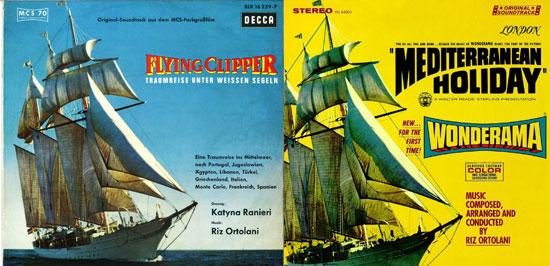 On
the left: The German "Decca" Original Soundtrack Album of the MCS 70
movie "Flying Clipper – Traumreise unter weißen Segeln" (from the
author's collection). On the right: The American "London Records" LP (a
U.S. division of the British Decca Label). On
the left: The German "Decca" Original Soundtrack Album of the MCS 70
movie "Flying Clipper – Traumreise unter weißen Segeln" (from the
author's collection). On the right: The American "London Records" LP (a
U.S. division of the British Decca Label).On the "London Records" LP cover is written: "You do all this and more because the Magic of "Wonderama" makes you part of the picture! New…for the first time! WONDERAMA. Filmed in Glorious Eastman Color and Sensational Surround Sound. A Walter Reade-Sterling Presentation." The German record sleeve (reverse side) gives following additional information: Music performed by the Munich Kurt Graunke Symphony Orchestra. Composer and conductor: Riz Ortolani – Lyrics: George David Weiss – Choir: Rudolf Lamy. Track listing: Side A.) Overture*, Arrival At Beirut, Impressions Of Greece, Have Faith*, At Monte Carlo, The Theme From Pharaohs, The Storm, Finale I (Grand Shangri-La). Side B.) Sing Sagapo*, Sailor's Day Out, Wherever You May Go*, Twist Around the World, Portugal (Ave Christo), Spanish Feria, Corrida, Finale II.* (*sung by Katyna Ranieri) |
|
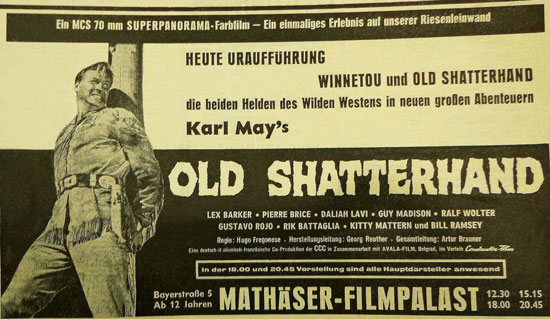 Also
a MCS 70 Superpanorama movie with 6-channel Stereo Sound mix ("music only"
is told): "Old Shatterhand" (West Germany / France / Italy / Yugoslavia,
1964). Advert taken from the "Münchner Merkur" newspaper. The festive World
Premiere took place at Munich's "Mathäser-Filmpalast" on Thursday, April 30,
1964. The movie ran there until May 28, 1964. Also
a MCS 70 Superpanorama movie with 6-channel Stereo Sound mix ("music only"
is told): "Old Shatterhand" (West Germany / France / Italy / Yugoslavia,
1964). Advert taken from the "Münchner Merkur" newspaper. The festive World
Premiere took place at Munich's "Mathäser-Filmpalast" on Thursday, April 30,
1964. The movie ran there until May 28, 1964. "A unique experience on our giant screen. Winnetou and Old Shatterhand, the two heroes of the Wild West, are having great new adventures. During 06.00 and 08.45 pm performances all protagonists are present." (Author's comment: The musical score of this movie was also composed by Riz Ortolani) |
|
| Go: back - top -
back issues -
news index Updated 22-01-25 |
